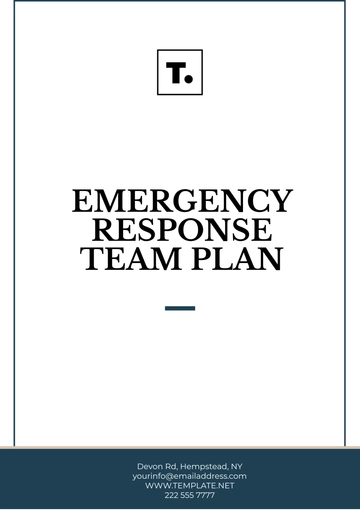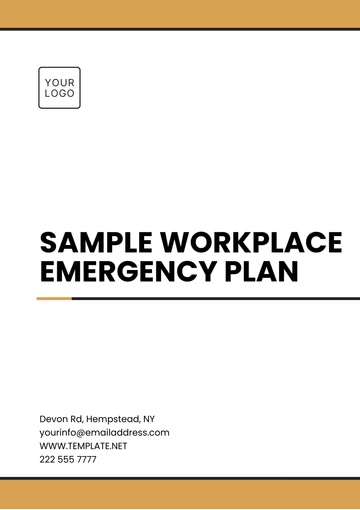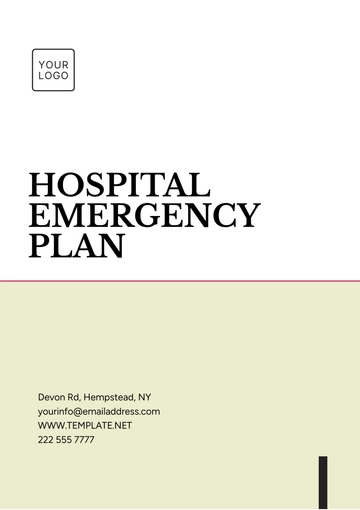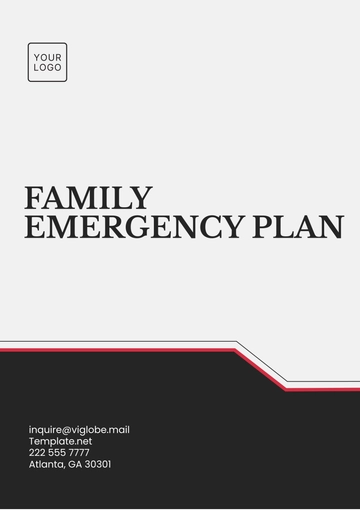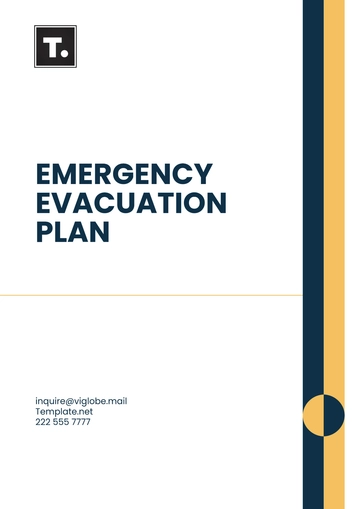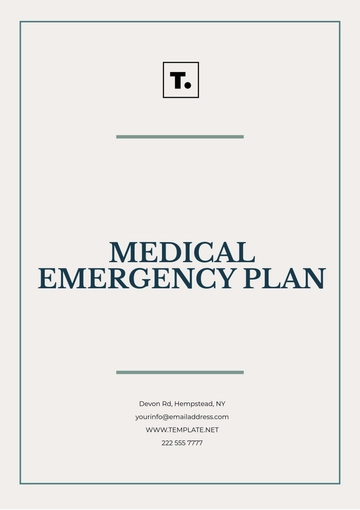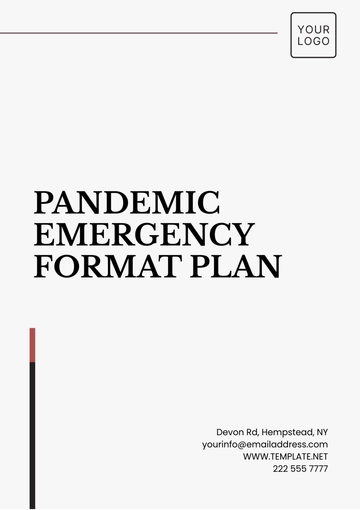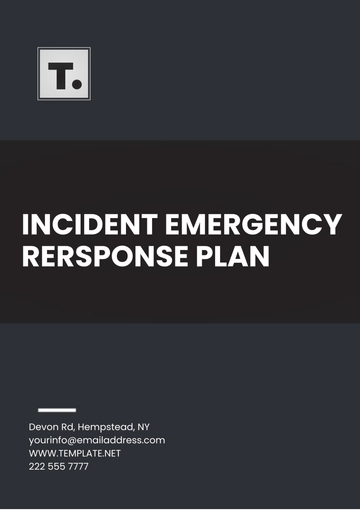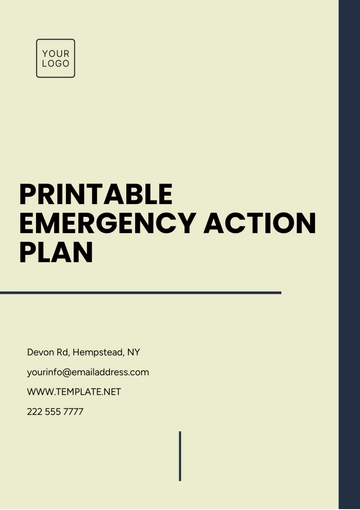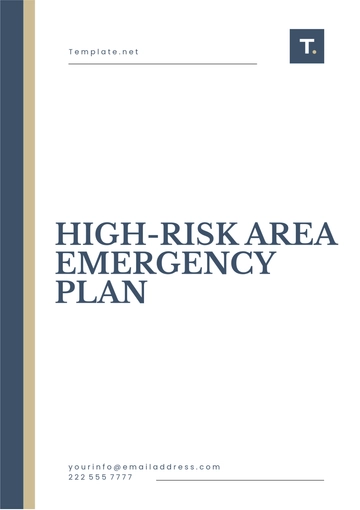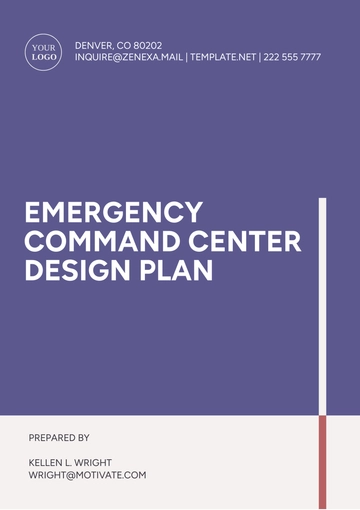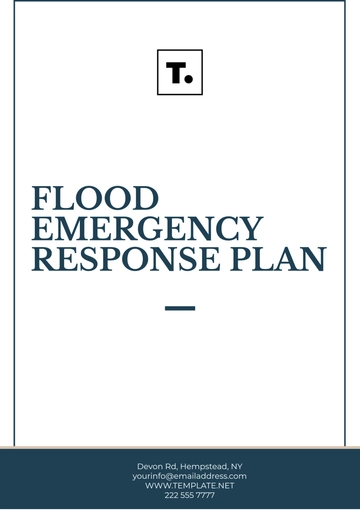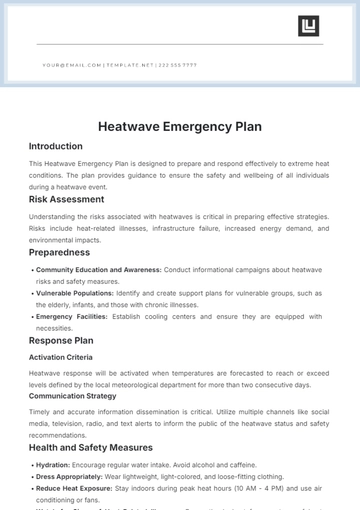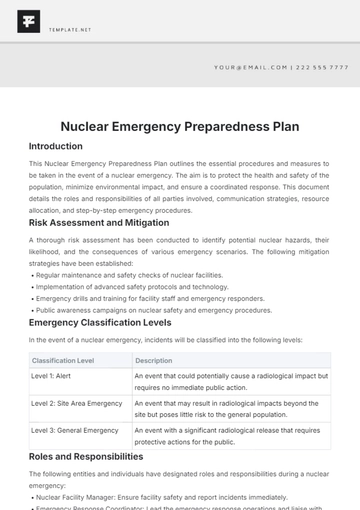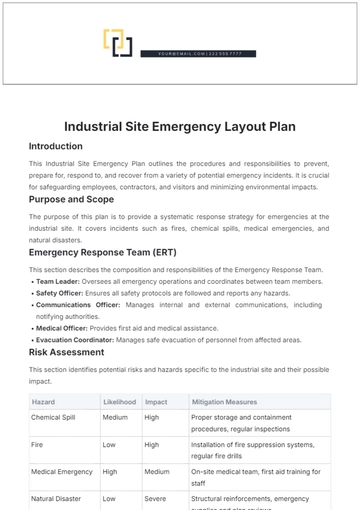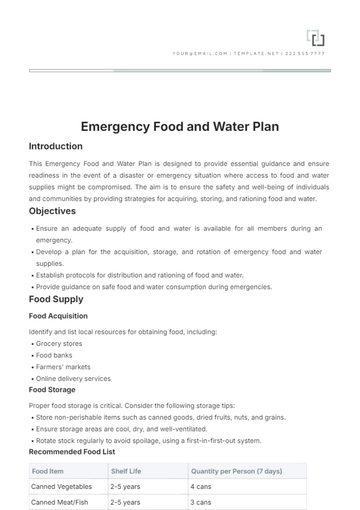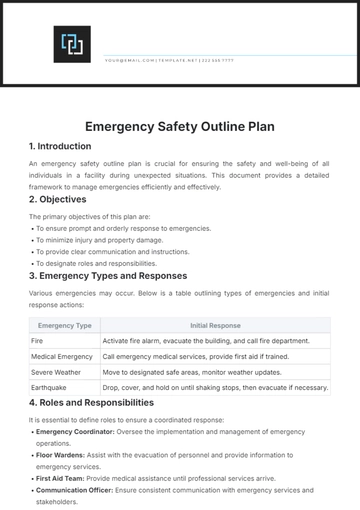Free Hazard Mitigation Emergency Plan
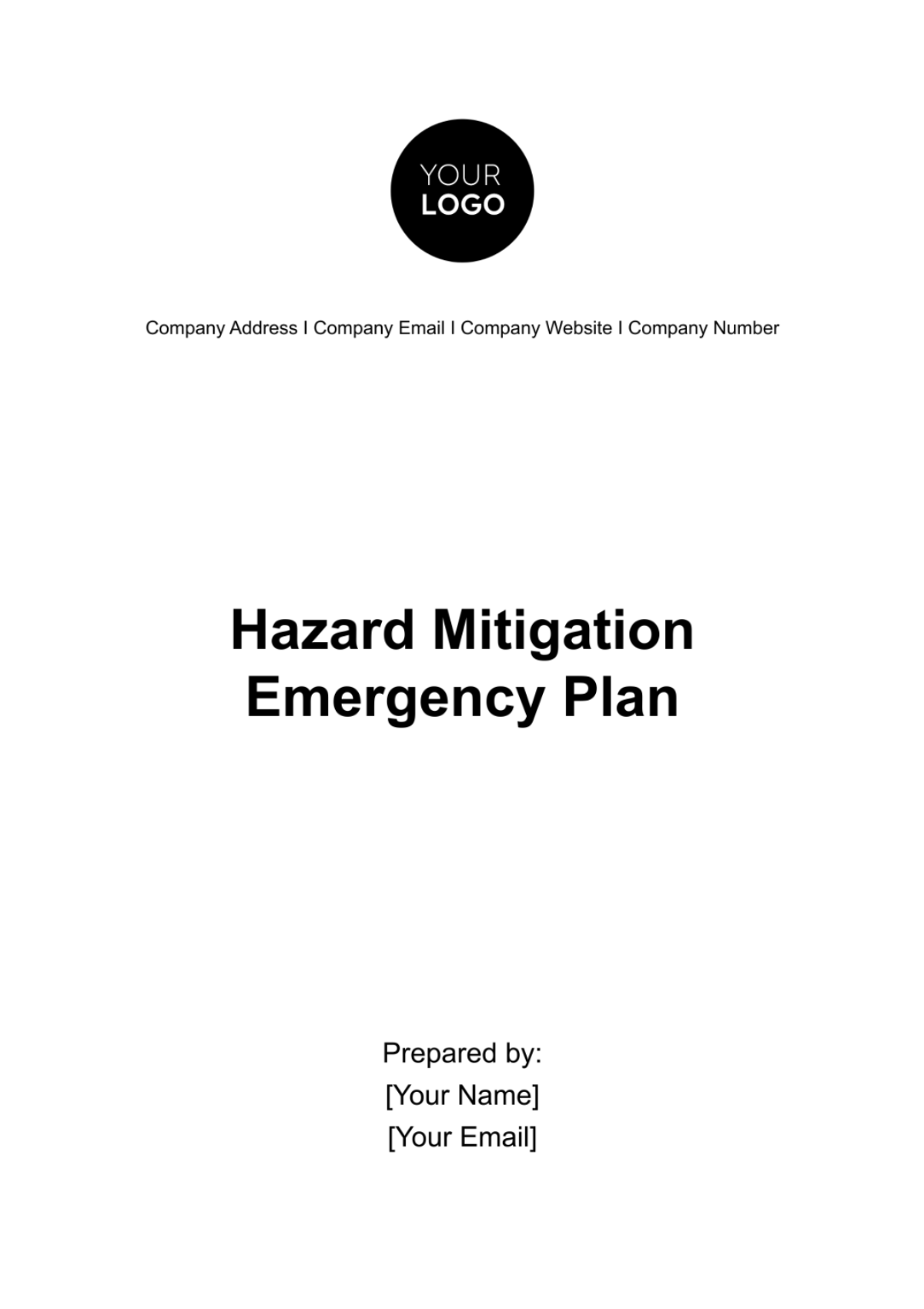
1. Executive Summary
[Your Company Name] is dedicated to safeguarding its employees, assets, and operations through proactive Hazard Mitigation and Emergency Planning. This comprehensive plan outlines our commitment to identifying, assessing, and mitigating potential hazards that could disrupt our business. We prioritize the safety and well-being of our employees and the continuity of our operations. This plan serves as our roadmap to resilience and preparedness.
2. Introduction
1.1 Purpose of the Plan
Emergencies and disasters can strike at any time, and their impact on a business can be significant. The purpose of this Hazard Mitigation Emergency Plan is to establish a structured approach to identify, assess, and mitigate potential hazards and risks that could affect [Your Company Name]. By doing so, we aim to minimize the disruption of our operations, protect our employees, and ensure business continuity.
1.2 Scope of the Plan
This plan covers a wide range of hazards and emergencies that could impact our organization, including but not limited to natural disasters, technological incidents, and human-made threats. It outlines the strategies, procedures, and resources we have in place to effectively respond to these events. The plan is designed to be adaptable to various scenarios and serves as a reference for our employees and stakeholders during times of crisis.
1.3 Plan Objectives
The objectives of this Hazard Mitigation Emergency Plan are as follows:
To identify and assess potential hazards and risks.
To develop strategies and measures to mitigate these hazards.
To establish clear emergency response procedures.
To ensure the safety and well-being of our employees and stakeholders.
To maintain the continuity of our essential business functions.
To facilitate effective communication and coordination during emergencies.
3. Risk Assessment
3.1. Hazard Identification
3.1.1 Purpose
The Hazard Identification section aims to identify and document potential hazards that could impact [Your Company Name]. By systematically identifying these hazards, we can take proactive measures to mitigate risks and prepare for potential emergencies.
3.1.2 Methodology
The hazard identification process involves a comprehensive review of various sources, including historical data, industry benchmarks, and expert consultations. This process ensures that we consider a wide range of hazards, both natural and human-made, that could affect our organization.
Table: Identified Hazards
Hazard Type | Description |
Natural Disasters | - Earthquakes, floods, hurricanes, etc. |
Technological Hazards | - Power outages, equipment failures, etc. |
Human-Made Threats | - Cyberattacks, industrial accidents, etc. |
Environmental Hazards | - Chemical spills, pollution incidents, etc. |
3.2. Risk Analysis
3.2.1 Purpose
Risk analysis involves assessing the likelihood and potential impact of identified hazards on our organization. This analysis helps prioritize hazards and determine which ones require immediate attention and mitigation efforts.
3.2.2 Methodology
We employ a quantitative and qualitative approach to risk analysis. Quantitative analysis involves assigning numerical values to the likelihood and impact of each hazard, allowing us to prioritize them effectively. Qualitative analysis considers non-financial impacts such as reputational damage and regulatory compliance.
Table: Risk Assessment Matrix
Hazard Type | Likelihood (1-5) | Potential Impact (1-5) | Risk Level (Likelihood x Impact) |
Natural Disasters | 4 | 5 | 20 |
Technological Hazards | 3 | 4 | 12 |
Human-Made Threats | 5 | 3 | 15 |
Environmental Hazards | 2 | 4 | 8 |
3.3. Vulnerability Assessment
3.3.1 Purpose
The vulnerability assessment aims to evaluate our organization's vulnerability to specific hazards. This assessment considers factors such as the location of our facilities, the robustness of our infrastructure, and the effectiveness of our emergency response plans.
3.3.2 Methodology
We conduct site-specific vulnerability assessments at our various locations. These assessments are guided by industry best practices and standards. The results help us identify areas where additional mitigation measures may be necessary to reduce vulnerabilities.
Table: Vulnerability Assessment Summary
Facility Location | Vulnerability Level | Mitigation Actions Required |
Headquarters | Moderate | - Strengthen building structures - Enhance cybersecurity measures |
Manufacturing Plant | High | - Implement disaster recovery plan - Conduct employee training |
Regional Offices | Low | - Review evacuation procedures - Update emergency contact lists |
4. Mitigation Strategies
4.1. Purpose
The Mitigation Strategies section outlines our proactive measures and actions to reduce the likelihood and impact of identified hazards. These strategies are designed to strengthen our organization's resilience and preparedness for potential emergencies.
4.2. Hazard-Specific Mitigation
We have developed hazard-specific mitigation strategies tailored to the types of hazards identified in the Risk Assessment section. Each strategy addresses the unique characteristics and challenges posed by specific hazards.
Table: Hazard-Specific Mitigation Strategies
Hazard Type | Mitigation Strategies |
Natural Disasters | - Seismic retrofitting of buildings - Flood-proofing infrastructure - Establishing early warning systems |
Technological Hazards | - Implementing redundant power supply systems - Conducting regular equipment maintenance - Cybersecurity enhancements |
Human-Made Threats | - Developing a comprehensive cybersecurity policy - Conducting security drills and training - Access control measures |
Environmental Hazards | - Implementing spill containment and cleanup procedures - Environmental impact assessments - Compliance with regulations |
4.3. General Mitigation Measures
In addition to hazard-specific strategies, we have identified general mitigation measures that apply across various hazards. These measures aim to enhance overall preparedness and reduce vulnerabilities.
Table: General Mitigation Measures
Mitigation Measure | Description |
Business Continuity Planning | Develop and maintain business continuity plans and procedures. |
Employee Training and Awareness | Conduct regular training sessions to educate employees about emergency procedures and safety measures. |
Emergency Response Drills | Conduct drills and exercises to ensure employees are familiar with emergency response protocols. |
Communication Enhancement | Improve communication systems and establish alternative communication methods in case of disruptions. |
Resource Stockpiling and Redundancy | Maintain essential supplies and equipment to ensure continued operations during emergencies. |
Partnerships and Collaborations | Collaborate with local authorities, emergency services, and neighboring businesses to enhance emergency response capabilities. |
4.4. Implementation Timeline
We have established an implementation timeline to prioritize and execute the mitigation strategies outlined in this section. The timeline ensures that mitigation measures are systematically put in place to enhance our preparedness.
Table: Mitigation Implementation Timeline
Strategy | Priority | Target Completion Date |
Seismic Retrofitting | High | [Month Day Year] |
Business Continuity Planning | Medium | [Month Day Year] |
Employee Training | High | [Month Day Year] |
Communication Enhancement | Medium | [Month Day Year] |
Cybersecurity Enhancements | High | [Month Day Year] |
The Mitigation Strategies section provides a comprehensive overview of our proactive measures to reduce risks and vulnerabilities. These strategies are essential steps toward strengthening our organization's resilience and minimizing the impact of potential hazards and emergencies.
5. Emergency Response Plan
5.1. Activation and Notification
5.1.1 Purpose
The Activation and Notification section outlines the procedures for initiating our emergency response plan when a hazard or emergency situation occurs. It defines the roles and responsibilities of key personnel responsible for activating the plan and notifying relevant parties.
Table: Activation and Notification Procedures
Action | Responsibility | Communication Method |
Hazard Identification | All employees | Immediate reporting to supervisor or safety officer. |
Emergency Activation | Emergency Coordinator | Activating the emergency response plan and notifying response teams. |
Notification of Authorities | Emergency Coordinator | Contacting local authorities, emergency services, and regulatory agencies as required. |
Employee Notification | Employee Representatives | Communicating with employees using designated communication channels. |
Public Notification | Public Relations Team | Issuing public notifications through official channels and media. |
5.2. Emergency Procedures
5.2.1 Purpose
The Emergency Procedures section provides detailed instructions for responding to specific types of emergencies, including natural disasters, technological incidents, and human-made threats. It specifies the actions to be taken by employees and response teams to ensure the safety of personnel and assets.
Table: Emergency Procedures
Emergency Type | Procedure |
Fire Emergency | - Evacuation procedures<br> - Activation of fire suppression systems |
Severe Weather | - Shelter-in-place instructions<br> - Safe locations within the facility |
Cybersecurity Breach | - Isolation of affected systems<br> - Reporting to the IT team |
Chemical Spill | - Evacuation procedures<br> - Use of personal protective equipment (PPE) |
Power Outage | - Activation of backup power sources<br> - Essential systems and equipment shutdown |
5.3. Evacuation Plan
5.3.1 Purpose
The Evacuation Plan section details the procedures for the safe and orderly evacuation of personnel and visitors in the event of an emergency that requires evacuation. It includes evacuation routes, assembly points, and responsibilities.
Table: Evacuation Plan
Evacuation Procedure | Responsibility | Evacuation Route | Assembly Point |
Fire Evacuation | All employees | Designated exits | Parking lot A |
Severe Weather Evacuation | Employee Representatives | Safe indoor areas | Designated shelters |
Chemical Spill Evacuation | Safety Officer | Evacuation routes | Remote assembly area |
Building Evacuation Drill | Emergency Coordinator | Predetermined routes | Assembly area C |
The Emergency Response Plan section provides a structured framework for activating, notifying, and responding to emergencies. It ensures that employees and response teams are well-prepared to take appropriate actions to mitigate risks and ensure the safety of all individuals involved.
6. Communication Plan
6.1. Purpose
The Communication Plan is a critical component of our emergency response strategy. It outlines the procedures and channels for effective communication during emergencies to ensure that information is disseminated accurately and promptly to all relevant stakeholders.
6.2. Communication Channels
6.2.1. Internal Communication
Internal communication focuses on keeping our employees informed and safe during emergencies. We utilize various communication channels to achieve this:
Table: Internal Communication Channels
Communication Channel | Purpose |
Internal Emails | Timely updates and instructions. |
In-Person Meetings | Face-to-face communication for critical information. |
Intranet Portal | Posting emergency updates and procedures. |
6.2.2. External Communication
External communication is crucial for informing authorities, partners, the public, and the media about our emergency situation and response efforts:
Table: External Communication Channels
Communication Channel | Purpose |
Phone Calls | Direct communication with authorities and partners. |
Video Conferences | Virtual meetings for coordination and information sharing. |
Official Reports | Regulatory reporting and compliance. |
Social Media Updates | Public information dissemination and engagement. |
Public Meetings | Town hall meetings and forums for community engagement. |
6.3. Communication Protocols
6.3.1. Emergency Notification System
We have established an emergency notification system to ensure rapid and efficient communication during emergencies. This system includes predefined notification lists and procedures for activation.
6.3.2. Chain of Command
A clear chain of command is established to facilitate the flow of information. The Emergency Coordinator, Communication Officer, and Stakeholder Liaison are responsible for coordinating communication efforts.
6.3.3. Reporting Procedures
Employees and designated personnel are trained to follow specific reporting procedures, ensuring that critical information reaches the appropriate authorities and response teams promptly.
6.4. Stakeholder Communication
Stakeholder communication is vital to maintaining trust and transparency during emergencies. We are committed to keeping our stakeholders informed about our response efforts and any potential impact on them.
Table: Stakeholder Communication
Stakeholder Group | Communication Method |
Employees | Regular updates and instructions through internal channels. |
Partners | Direct communication regarding the status of our operations and partnerships. |
Authorities | Compliance reporting and coordination through official channels. |
Public | Timely and accurate public information via social media, press releases, and public meetings. |
The Communication Plan ensures that our organization has the necessary protocols and channels in place to communicate effectively with both internal and external stakeholders during emergencies, enabling a coordinated and informed response.
7. Resource Allocation
7.1. Purpose
Resource allocation is a critical aspect of our emergency preparedness. This section outlines how we allocate the necessary resources to support our emergency response efforts effectively. Resources encompass personnel, equipment, supplies, and financial resources.
7.2. Personnel
7.2.1. Emergency Response Team
We have designated and trained an Emergency Response Team (ERT) responsible for managing and executing emergency response activities. The team includes the following key roles:
Table: Emergency Response Team Roles
Role | Responsibilities |
Emergency Coordinator | Overall coordination of emergency response. |
Communication Officer | Development of communication strategies. |
Stakeholder Liaison | Liaison between stakeholders and response teams. |
Employee Representatives | Relay information to employees. |
Public Relations Team | Management of public communication. |
8. Conclusion
In conclusion, our Hazard Mitigation Emergency Plan represents our unwavering commitment to safeguarding our organization against potential hazards and crises. By systematically assessing risks, implementing mitigation strategies, and ensuring effective response measures, we are well-prepared to navigate emergencies while minimizing their impact. This plan reflects our dedication to resilience and adaptability in the face of adversity, ensuring the safety and continuity of our operations.
- 100% Customizable, free editor
- Access 1 Million+ Templates, photo’s & graphics
- Download or share as a template
- Click and replace photos, graphics, text, backgrounds
- Resize, crop, AI write & more
- Access advanced editor
Uncover the essential resource for proactive risk management with Template.net's Hazard Mitigation Emergency Plan Template. This editable and customizable template, powered by our Ai Editor Tool, streamlines the development of tailored hazard mitigation strategies. Safeguard lives and assets effectively with Template.net's comprehensive and innovative solutions.
You may also like
- Finance Plan
- Construction Plan
- Sales Plan
- Development Plan
- Career Plan
- Budget Plan
- HR Plan
- Education Plan
- Transition Plan
- Work Plan
- Training Plan
- Communication Plan
- Operation Plan
- Health And Safety Plan
- Strategy Plan
- Professional Development Plan
- Advertising Plan
- Risk Management Plan
- Restaurant Plan
- School Plan
- Nursing Home Patient Care Plan
- Nursing Care Plan
- Plan Event
- Startup Plan
- Social Media Plan
- Staffing Plan
- Annual Plan
- Content Plan
- Payment Plan
- Implementation Plan
- Hotel Plan
- Workout Plan
- Accounting Plan
- Campaign Plan
- Essay Plan
- 30 60 90 Day Plan
- Research Plan
- Recruitment Plan
- 90 Day Plan
- Quarterly Plan
- Emergency Plan
- 5 Year Plan
- Gym Plan
- Personal Plan
- IT and Software Plan
- Treatment Plan
- Real Estate Plan
- Law Firm Plan
- Healthcare Plan
- Improvement Plan
- Media Plan
- 5 Year Business Plan
- Learning Plan
- Marketing Campaign Plan
- Travel Agency Plan
- Cleaning Services Plan
- Interior Design Plan
- Performance Plan
- PR Plan
- Birth Plan
- Life Plan
- SEO Plan
- Disaster Recovery Plan
- Continuity Plan
- Launch Plan
- Legal Plan
- Behavior Plan
- Performance Improvement Plan
- Salon Plan
- Security Plan
- Security Management Plan
- Employee Development Plan
- Quality Plan
- Service Improvement Plan
- Growth Plan
- Incident Response Plan
- Basketball Plan
- Emergency Action Plan
- Product Launch Plan
- Spa Plan
- Employee Training Plan
- Data Analysis Plan
- Employee Action Plan
- Territory Plan
- Audit Plan
- Classroom Plan
- Activity Plan
- Parenting Plan
- Care Plan
- Project Execution Plan
- Exercise Plan
- Internship Plan
- Software Development Plan
- Continuous Improvement Plan
- Leave Plan
- 90 Day Sales Plan
- Advertising Agency Plan
- Employee Transition Plan
- Smart Action Plan
- Workplace Safety Plan
- Behavior Change Plan
- Contingency Plan
- Continuity of Operations Plan
- Health Plan
- Quality Control Plan
- Self Plan
- Sports Development Plan
- Change Management Plan
- Ecommerce Plan
- Personal Financial Plan
- Process Improvement Plan
- 30-60-90 Day Sales Plan
- Crisis Management Plan
- Engagement Plan
- Execution Plan
- Pandemic Plan
- Quality Assurance Plan
- Service Continuity Plan
- Agile Project Plan
- Fundraising Plan
- Job Transition Plan
- Asset Maintenance Plan
- Maintenance Plan
- Software Test Plan
- Staff Training and Development Plan
- 3 Year Plan
- Brand Activation Plan
- Release Plan
- Resource Plan
- Risk Mitigation Plan
- Teacher Plan
- 30 60 90 Day Plan for New Manager
- Food Safety Plan
- Food Truck Plan
- Hiring Plan
- Quality Management Plan
- Wellness Plan
- Behavior Intervention Plan
- Bonus Plan
- Investment Plan
- Maternity Leave Plan
- Pandemic Response Plan
- Succession Planning
- Coaching Plan
- Configuration Management Plan
- Remote Work Plan
- Self Care Plan
- Teaching Plan
- 100-Day Plan
- HACCP Plan
- Student Plan
- Sustainability Plan
- 30 60 90 Day Plan for Interview
- Access Plan
- Site Specific Safety Plan

